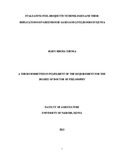| dc.description.abstract | Charcoal is the principal cooking fuel in Kenya which provides energy to 82% of urban and 34% of rural households. Poor households are opting to use unhealthy sources of fuel such as tyres, old shoes and plastics especially those in urban and peri-urban areas while many families are shifting from traditional meals that require long cooking times and are compromising dietary diversity and nutrition as a result. Faced with poverty and unemployment, communities are turning to fuel briquette which is made by compressing biomass material into a solid unit. Fuel briquette production methods in Nairobi and surroundings and their implications on the quality of the product were studied through focus group discussions with eight groups and one private company. The fuel briquette producing community SHG‘s in Nairobi comprised all those identified and located using an existing database on self-help groups involved in waste management in Nairobi. One group SHG that produced sawdust fuel briquettes was identified in Naro Moro through PactKe an NGO working on Natural Resource Management in Laikipia county.
Implications of fuel briquettes on the community livelihoods were also investigated. Theresults obtained were applied in designing experiments to assess different fuel briquettes producing techniques using, (i) different binders namely soil, paper, cowdung and gum Arabica, (ii) pressing machines, (iii) charcoal dust from Acacia mearnsii, Eucalyptus spp and Acacia xanthophloea,(iv) sawdust from Grevillia robusta, Pinus patulaandCupressus lusitanica and (v) carbonized sawdust from the three tree species above in (iv).combustion characteristics which included calorific value, ash content and volatile matter of the fuel briquettes were conducted through Infrared (IR) spectroscopy and wet chemistry.In Near-infrared (NIR) and Mid-infrared (Mid-IR) the MPA Multi Purpose FT-NIR Analyzer and Tensor 27–HTS-XTBruker FTIR equipments were used respectively. A double sampling approach was used whereby a spectral library of the total 40 samples for each type of fuel briquette and pure charcoal was first established and then a representative subset selected based on the chemical and physical spectral diversity in the library. These subset samples were analyzed for ash content, calorific value and volatile matter using wet chemistry. Calorific value was measured using bomb calorimeter while volatile matter was measured using 0.5g of the sample which was heated in a furnace at 800C for five minutes. Volatile matter was then expressed as the percentage of loss of weight of the original sample. The ash content was determined the same way as volatile matter but this time the sample was heated for 1.5 to 2 hours.Carbon monoxide (CO) was measured at 10 seconds intervals using EL-USB-CO carbon monoxide data logger, DATAQ Instruments(603-746-5524). Fine particulate matter (PM2.5) measurements were taken per minute using a particulate matter meter, UCB, Berkeley Air Monitoring Group. Carbon dioxide was measured at intervals of 5 minutes using Taile 7001 Carbon Dioxide and Temperature, LASCAR(603-746-5524).
Locally produced charcoal dust briquettes bonded with corn starch or paper had the
highest calorific values of 23.6kJ/g and 21.4kJ/g respectively. While comparing with
locally produced fuel briquettes, quality of charcoal dust bonded with paper and charcoal
dust bonded with soil briquettes rose by 25% and 75% respectively. Contaminants
comprising of chromium, mercury and lead were high in briquette made from organic
waste as the feed stock in the informal settlements and dump sites. Burning sawdust
briquettes bonded with gum arabica emitted high levels of PM2.5. Carbonizing raw
sawdust for fuel briquette production increased calorific value by 40% and reduced
indoor air concentration (IAC) of CO and PM2.5 by 67% and 98% respectively.Type of
tree species from which charcoal dust was sourced influenced combustion properties and IAC of PM2.5 of fuel briquettes while type of sawdust influenced IAC of PM2.5.Fuel
briquettes made from charcoal dust bonded soil performed the best when both
combustion and emission qualities were considered. Supplying energy and cooking a
traditional meal with charcoal briquettes and charcoal accounts for 1.3 and 4.9-6.3 kg
CO2e. per meal respectively if forests are not regenerated. These amounts decline to 0.18 and 1.9 kg CO2 eq. per meal for charcoal briquette and charcoal when carbon dioxide from carbonization and cooking stages is taken up by regrowing biomass. Adopting improved wood production and wood carbonization systems will result in additional cooking fuel supply and reduced GWP. It is critical for households to adopt technologies that increase fuel efficiency and reduce emissions from cooking with charcoal briquettes and charcoal.There is need to improve the quality of fuel briquettes produced by community groups through trainings while scaling out of high quality fuel briquettes such as that made from charcoal dust bonded with soil is desirable. | en |

